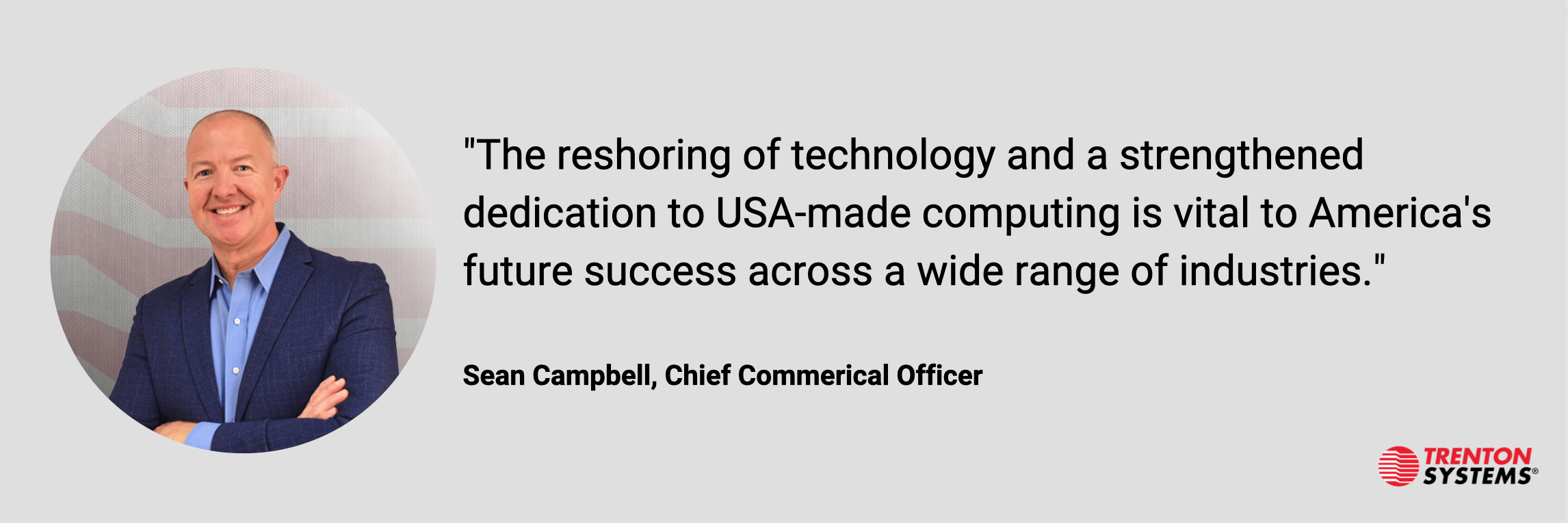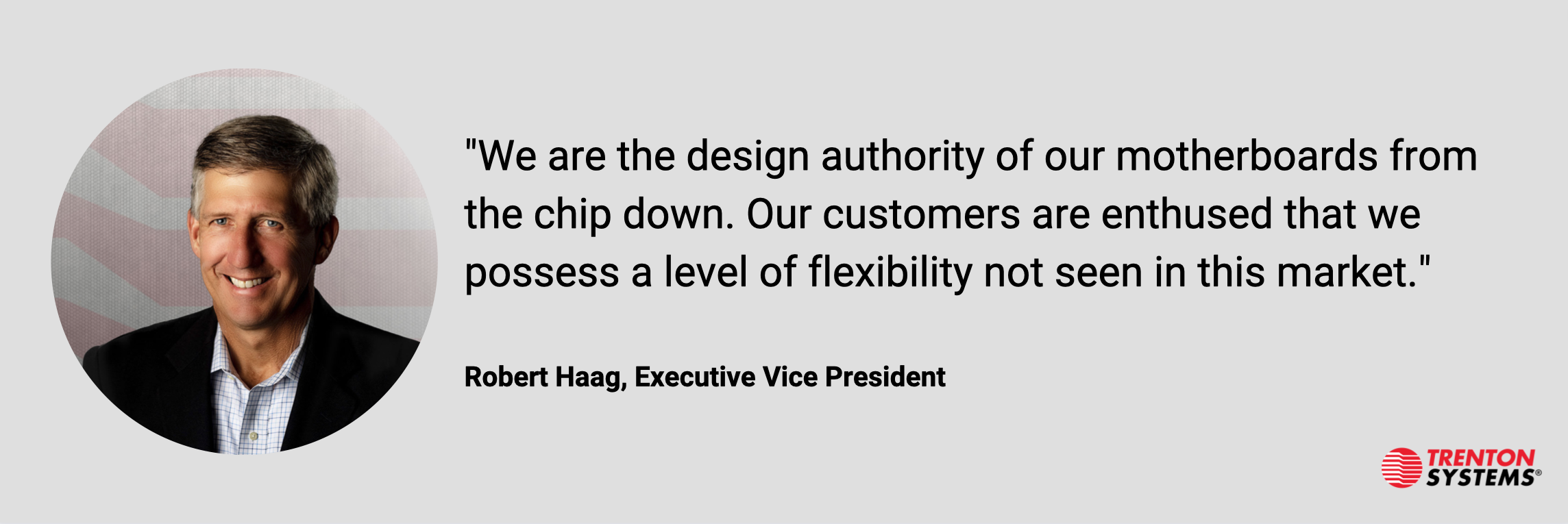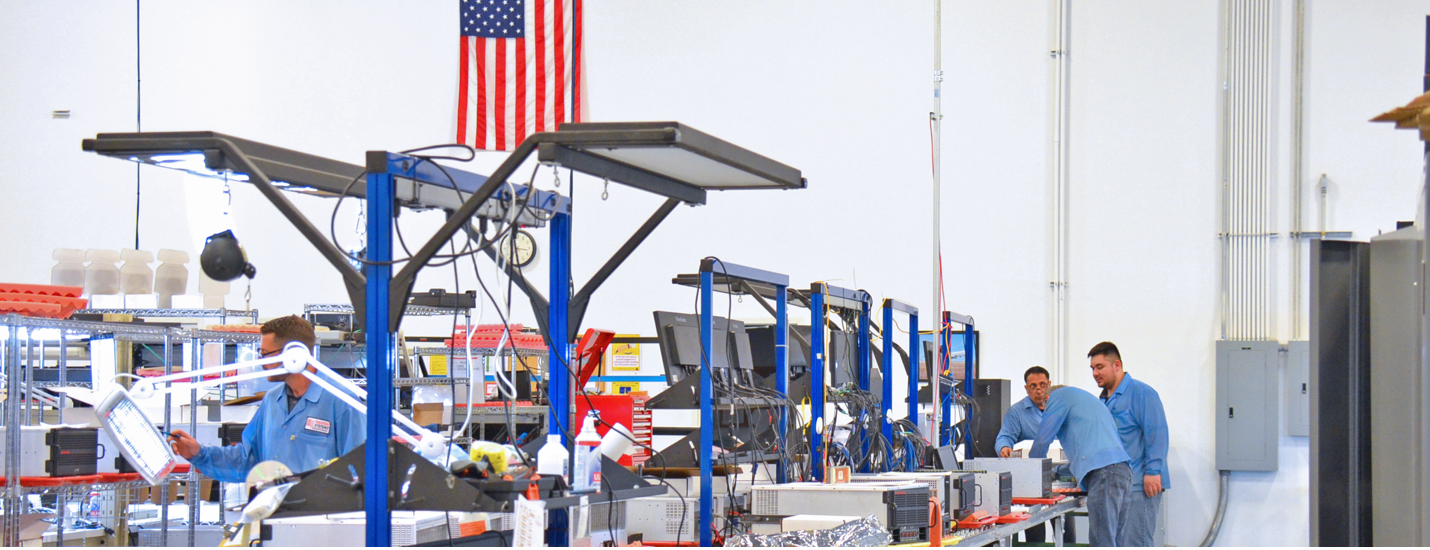Share this
Supply Chain 2022 Q&A: What You Need to Know
by Yazz Krdzalic on Jul 26, 2022 9:23:30 AM

Since the start of COVID, the global supply chain has been fraught with shortages, extended lead times, and astronomical cost increases.
Additionally, Chinese and Taiwanese manufacturers have drastically reduced production at the same time demand for new technologies used in all sorts of systems and appliances has exploded.
This has led to a widespread availability problem that opens the door to the injection of counterfeit parts, pieces, and components that can compromise the functionality and safety of mission-critical applications.
I recently sat down with other members of Trenton's executive leadership team:
- Jason Barr, Chief Operations Officer
- Sean Campbell, Chief Commercial Officer
- Robert Haag, Executive Vice President
We talked extensively about our currently constricted supply chain, how Trenton's risk management process is helping our customers navigate these limitations, and how this has led to a renewed dedication to USA-made computing.
What are some of the biggest issues we are seeing with the supply chain right now?
Jason Barr
Well, the supply chain has certainly put a strain on availability. We have boards with numerous critical components, and the absence of just one can mean that we are not able to ship our systems for customers.
On top of this, we've seen lead times that have been extended by as much as two years. When parts are scarce, that increases opportunities for nefarious players to infiltrate the supply chain with bad parts. Now, they could just be out to make money with counterfeit parts, or they could be hackers looking to compromise the security of top-secret information.
In addition to shortages, we are also getting end-of-life (EOL) notices with no runway. Usually, when we receive EOL notices, we have some time to buy a part until it is no longer available. Now, however, we have been getting these notices, but we don't have any time to get these parts because they have just disappeared.
Even worse, over half the world's neon supply--which is critical to the etching process of silicon for semiconductors--comes from Ukraine, and with the current conflict between Russia and Ukraine, neon has been hard to come by. This further highlights the need for legislation like the CHIPS Act to support US manufacturing of computer hardware and other components.
Sean Campbell
If COVID has taught us anything, it's that we have grossly undersupported USA manufacturing. Critical parts, pieces, and components that have traditionally been made overseas for the past 20 years or so have just vanished.
This further emphasizes that the reshoring of technology and a strengthened dedication to USA-made computing is vital to America's future success across a wide range of industries.
Robert Haag
I would say that there are three primary issues that we are facing right now. First, lead times on components that are key to the products that we are designing are unpredictable. Second, components have been disappearing from the marketplace with no notice. Third, the costs of parts, pieces, and components have skyrocketed, and we've even seen multiple price increases on the same component.
I’m pleased that our company has the right skill sets to efficiently navigate around these challenges.
What caused these supply chain and logistical issues to arise?
Jason Barr
The shutdown and reopening of the supply chain and production as a result of COVID had a compounding effect.
During lockdown, people could not spend money on services such as restaurants, shows, sporting events, or vacations; instead, they bought products, particularly electronics.
Whether it was for home offices or entertainment purposes, this demand depleted the electronic component supply chain. Compounding the issue, many of the electronic component manufacturers remained in lockdown, thus the rapidly depleting supply chain was not being refilled.
Additionally, there was a huge increase in artificial demand. Manufacturers feared that components would soon be unavailable--the toilet paper fiasco comes to mind--so they bought that commodity in larger quantities than necessary.
Couple this type of demand with actual demand as well as decreased production and availability issues, and what do you get? Extended lead times and astronomical price increases. It's a tough situation out there.
Sean Campbell
COVID had a huge impact on the manufacturing environment in Asia, and it really hampered the ability of factories to put out chips, Ethernet controllers, NIC cards, power supplies, and voltage regulators.
But the thing is, this has impacted not just the high-performance computing industry, but every industry that uses semiconductors and other computing components. It's a widespread pain.
Robert Haag
Well, COVID obviously put a huge strain on manufacturing across the globe. China, adhering to its "zero-tolerance" policy, shut down factories in many parts of the country, leading to massive shortages.
At the same time all of this was, and still is, happening, there has been a huge increase in demand for parts, pieces, and components that were not available years ago, not only for use in computers but also in appliances like cards and washing machines.
Add high demand and limited supply together, and the result is astronomical price increases.

What parts, pieces, and components have been the hardest to obtain?
Jason Barr
It seems that the parts that are hardest to get are voltage regulators, Ethernet controllers, NIC cards, and connectors.
Sean Campbell
From what I've seen, we've had the most trouble obtaining Ethernet controllers, chips, voltage regulators, power supplies, and NIC cards.
Robert Haag
I would say that the components that are hardest to obtain are chips, voltage regulators, Ethernet controllers, along with other packaged components.
How long are these supply chain issues expected to last?
Jason Barr
I thought this would have been over long before now. Additional shutdowns and the war in Ukraine have put additional constraints on the supply chain, but we should start seeing some relief by the second quarter of 2023.
Sean Campbell
All indications seem to say that we will start to see some normalcy again by the end of 2023.
Robert Haag
Based on current estimates, the end of 2023 is when we start to tug out of this.
Let me provide some perspective. In 2021, there were over 30 fab (fabrication) projects announced across the globe, and only four of them were in the US. The rest were in China and Taiwan. Intel® is projecting a five percent increase in demand for chips every year until 2030.
Production will primarily take place in four countries: the US, China, Taiwan, and South Korea. Legislation like the CHIPS Act will be critical in providing some of the funding necessary to keep up with this demand, but even then, it will be just a start.

How is Trenton helping to mitigate some of these issues?
Jason Barr
Our biggest advantage is that we own the design of our board down to the chip level. If a part goes missing, we are able to engineer in an alternative or, if appropriate, purchase one from a supplier on our approved vendor list (AVL).
We can spin the design of our boards with the help of our electrical designers and layout engineers, rearranging circuitry or finding new components without alteration to form, fit, or function. In some cases, this results in an even better product for our customer.
Something that we can also do is incorporate an interposer board into our solution. If a component becomes unavailable, we might find an alternate component that functions the same but has a different footprint.
Rather than redesigning the entire motherboard to accommodate the alternate component, we can engineer an interposer board that routes the leads on the alternate component to the appropriate pads on the motherboard.
Sean Campbell
We offer counterfeit parts protection (CPP), firmware (BIOS) control, supplier quality surveys, end-of-life notices (EOL), and strict revision control.
Most importantly, we have a very good story in helping local design, development, and software integration when obsolete components cannot be delivered by respinning existing solutions internally to help offset manufacturing ability through existing components.
Robert Haag
Our supply chain risk management techniques include counterfeit parts protection (CPP), firmware (BIOS) control, supplier quality surveys, end-of-life notices (EOL), and strict revision control.
What really provides an advantage, however, is that we are able to engineer alternative parts and components that disappear in the supply chain, allowing programs to keep going.
If a controller or memory, for example, goes missing, we are able to navigate around that with our engineering capabilities, and this is something that our competitors are not able to do.
How have customers responded to Trenton's supply chain risk management process?
Jason Barr
I would say what customers appreciate the most is flexibility and vigilance we demonstrate. We have some great relationships with our authorized distributors and have been able to access inventory that is only available through allocation.
Additionally, we can engineer in alternative parts, and we are able to spin our boards when necessary.
Sean Campbell
We currently offer one of the most robust chain of custody solutions in the high-performance computing industry.
We maintain a cradle-to-grave ownership structure that values and manufactures available components, and this resonates with our customers within the DoD, military, aerospace, and defense sectors as well as with major programs of record.
Trenton Systems is a one-stop-shop for customized, SWaP-C optimized, high-performance computing designed, developed, and manufactured in the US.
Robert Haag
We are the design authority of our motherboards from the chip down. Our customers are enthused that we offer a level of flexibility not seen before in this market.
When I talk to customers, I lead with, "Trenton Systems offers supply chain risk mitigation, and we make our own boards." This instills confidence that we can help them naviagte these issues caused by our currently constricted supply chain, and we can keep their programs on schedule.

We ensure parts, pieces, and components are of the highest quality
Oftentimes, it is not just the lifecycle of a part that is a concern, but availability is also an issue, especially now. For instance, a component may be active in its lifecycle, but it may not be available.
Those companies and individuals facing availability issues may scramble to obtain them from an unauthorized distributor, opening the door to cyberattacks and/or installing an inferior component into their product and, ultimately, compromising a product's operational ability.
We avoid this by ensuring that all parts, pieces, and components come from an approved vendor list and go through a rigorous vetting process.
First, we check to make sure that all incoming components are from an authorized distributor, or an original equipment manufacturer (OEM). We then check their appearances, looking for inaccurate labels or damage.
If a part makes it past these inspections, then it can go on and continue into the lifecycle of a product. If it doesn't, then our purchasing department is notified, and we begin an investigation, locking up the component in question throughout the entire process.
We also have a program for incoming inspectors that provides them with various examples of what counterfeit parts and components look like, which can come into the process from anywhere at any time.
It is critical that we detect faulty and/or counterfeit parts, pieces, and components before they are incorporated into our products, as the malfunctioning of one of our systems can be life-threatening.
Our proactive supply chain risk management methodologies ensure that safe and reliable systems are incorporated into their proper end applications, allowing our warfighters to operate with complete confidence.

A tight grip on our supply chain
In the face of massive supply chain disruptions, customers are looking for a supplier who can help them mitigate some availability and lead time issues.
With solutions designed, manufactured, assembled, tested, and supported at our headquarters in Atlanta, Georgia, Trenton Systems can help address these concerns for customers across the military, industrial, and commercial sectors.
In addition to BIOS control, supplier quality surveys, alternative parts engineering, and end-of-life (EOL) notices, we ensure total integrity of all parts, pieces, and components at the board and chip level through an approved vendor list (AVL) and a counterfeit parts protection program (CPP).
With this extensive control of our production process and thorough vetting of components, we avoid incorporating faculty parts into our systems, avoiding functionality and safety problems before they manifest themselves.
Our high-performance computing solutions equip our warfighters with the best in USA-made technology in the face of supply chain constraints, helping to optimize performance, maximize security, and increase efficiency across the battlespace.
Share this
- High-performance computers (42)
- Military computers (38)
- Rugged computers (32)
- Cybersecurity (25)
- Industrial computers (25)
- Military servers (24)
- MIL-SPEC (20)
- Rugged servers (19)
- Press Release (17)
- Industrial servers (16)
- MIL-STD-810 (16)
- 5G Technology (14)
- Intel (13)
- Rack mount servers (12)
- processing (12)
- Computer hardware (11)
- Edge computing (11)
- Rugged workstations (11)
- Made in USA (10)
- Partnerships (9)
- Rugged computing (9)
- Sales, Marketing, and Business Development (9)
- Trenton Systems (9)
- networking (9)
- Peripheral Component Interconnect Express (PCIe) (7)
- Encryption (6)
- Federal Information Processing Standards (FIPS) (6)
- GPUs (6)
- IPU (6)
- Joint All-Domain Command and Control (JADC2) (6)
- Server motherboards (6)
- artificial intelligence (6)
- Computer stress tests (5)
- Cross domain solutions (5)
- Mission-critical servers (5)
- Rugged mini PCs (5)
- AI (4)
- BIOS (4)
- CPU (4)
- Defense (4)
- Military primes (4)
- Mission-critical systems (4)
- Platform Firmware Resilience (PFR) (4)
- Rugged blade servers (4)
- containerization (4)
- data protection (4)
- virtualization (4)
- Counterfeit electronic parts (3)
- DO-160 (3)
- Edge servers (3)
- Firmware (3)
- HPC (3)
- Just a Bunch of Disks (JBOD) (3)
- Leadership (3)
- Navy (3)
- O-RAN (3)
- RAID (3)
- RAM (3)
- Revision control (3)
- Ruggedization (3)
- SATCOM (3)
- Storage servers (3)
- Supply chain (3)
- Tactical Advanced Computer (TAC) (3)
- Wide-temp computers (3)
- computers made in the USA (3)
- data transfer (3)
- deep learning (3)
- embedded computers (3)
- embedded systems (3)
- firmware security (3)
- machine learning (3)
- Automatic test equipment (ATE) (2)
- C6ISR (2)
- COTS (2)
- COVID-19 (2)
- CPUs (2)
- Compliance (2)
- Compute Express Link (CXL) (2)
- Computer networking (2)
- Controlled Unclassified Information (CUI) (2)
- DDR (2)
- DDR4 (2)
- DPU (2)
- Dual CPU motherboards (2)
- EW (2)
- I/O (2)
- Military standards (2)
- NVIDIA (2)
- NVMe SSDs (2)
- PCIe (2)
- PCIe 4.0 (2)
- PCIe 5.0 (2)
- RAN (2)
- SIGINT (2)
- SWaP-C (2)
- Software Guard Extensions (SGX) (2)
- Submarines (2)
- Supply chain security (2)
- TAA compliance (2)
- airborne (2)
- as9100d (2)
- chassis (2)
- data diode (2)
- end-to-end solution (2)
- hardware security (2)
- hardware virtualization (2)
- integrated combat system (2)
- manufacturing reps (2)
- memory (2)
- mission computers (2)
- private 5G (2)
- protection (2)
- secure by design (2)
- small form factor (2)
- software security (2)
- vRAN (2)
- zero trust (2)
- zero trust architecture (2)
- 3U BAM Server (1)
- 4G (1)
- 4U (1)
- 5G Frequencies (1)
- 5G Frequency Bands (1)
- AI/ML/DL (1)
- Access CDS (1)
- Aegis Combat System (1)
- Armed Forces (1)
- Asymmetric encryption (1)
- C-RAN (1)
- COMINT (1)
- Cloud-based CDS (1)
- Coast Guard (1)
- Compliance testing (1)
- Computer life cycle (1)
- Containers (1)
- D-RAN (1)
- DART (1)
- DDR5 (1)
- DMEA (1)
- Data Center Modular Hardware System (DC-MHS) (1)
- Data Plane Development Kit (DPDK) (1)
- Defense Advanced Research Projects (DARP) (1)
- ELINT (1)
- EMI (1)
- EO/IR (1)
- Electromagnetic Interference (1)
- Electronic Warfare (EW) (1)
- FIPS 140-2 (1)
- FIPS 140-3 (1)
- Field Programmable Gate Array (FPGA) (1)
- Ground Control Stations (GCS) (1)
- Hardware-based CDS (1)
- Hybrid CDS (1)
- IES.5G (1)
- ION Mini PC (1)
- IP Ratings (1)
- IPMI (1)
- Industrial Internet of Things (IIoT) (1)
- Industry news (1)
- Integrated Base Defense (IBD) (1)
- LAN ports (1)
- LTE (1)
- Life cycle management (1)
- Lockheed Martin (1)
- MIL-S-901 (1)
- MIL-STD-167-1 (1)
- MIL-STD-461 (1)
- MIL-STD-464 (1)
- MOSA (1)
- Multi-Access Edge Computing (1)
- NASA (1)
- NIC (1)
- NIC Card (1)
- NVMe (1)
- O-RAN compliant (1)
- Oil and Gas (1)
- Open Compute Project (OCP) (1)
- OpenRAN (1)
- P4 (1)
- PCIe card (1)
- PCIe lane (1)
- PCIe slot (1)
- Precision timestamping (1)
- Product life cycle (1)
- ROM (1)
- Raytheon (1)
- Remotely piloted aircraft (RPA) (1)
- Rugged computing glossary (1)
- SEDs (1)
- SIM Card (1)
- Secure boot (1)
- Sensor Open Systems Architecture (SOSA) (1)
- Small form-factor pluggable (SFP) (1)
- Smart Edge (1)
- Smart NIC (1)
- SmartNIC (1)
- Software-based CDS (1)
- Symmetric encryption (1)
- System hardening (1)
- System hardening best practices (1)
- TME (1)
- Tech Partners (1)
- Total Memory Encryption (TME) (1)
- Transfer CDS (1)
- USB ports (1)
- VMEbus International Trade Association (VITA) (1)
- Vertical Lift Consortium (VLC) (1)
- Virtual machines (1)
- What are embedded systems? (1)
- Wired access backhaul (1)
- Wireless access backhaul (1)
- accredidation (1)
- aerospace (1)
- air gaps (1)
- airborne computers (1)
- asteroid (1)
- authentication (1)
- autonomous (1)
- certification (1)
- cognitive software-defined radios (CDRS) (1)
- command and control (C2) (1)
- communications (1)
- cores (1)
- custom (1)
- customer service (1)
- customer support (1)
- data linking (1)
- data recording (1)
- ethernet (1)
- full disk encryption (1)
- hardware monitoring (1)
- heat sink (1)
- hypervisor (1)
- in-house technical support (1)
- input (1)
- integrated edge solution (1)
- international business (1)
- licensed spectrum (1)
- liquid cooling (1)
- mCOTS (1)
- microelectronics (1)
- missile defense (1)
- mixed criticality (1)
- moving (1)
- multi-factor authentication (1)
- network slicing (1)
- neural networks (1)
- new headquarters (1)
- next generation interceptor (1)
- non-volatile memory (1)
- operating system (1)
- output (1)
- outsourced technical support (1)
- post-boot (1)
- pre-boot (1)
- private networks (1)
- public networks (1)
- radio access network (RAN) (1)
- reconnaissance (1)
- rugged memory (1)
- secure flash (1)
- security (1)
- self-encrypting drives (SEDs) (1)
- sff (1)
- software (1)
- software-defined radios (SDRs) (1)
- speeds and feeds (1)
- standalone (1)
- storage (1)
- systems (1)
- tactical wide area networks (1)
- technical support (1)
- technology (1)
- third-party motherboards (1)
- troposcatter communication (1)
- unlicensed spectrum (1)
- volatile memory (1)
- vpx (1)
- zero trust network (1)
- January 2025 (1)
- November 2024 (1)
- October 2024 (1)
- August 2024 (1)
- July 2024 (1)
- May 2024 (1)
- April 2024 (3)
- February 2024 (1)
- November 2023 (1)
- October 2023 (1)
- July 2023 (1)
- June 2023 (3)
- May 2023 (7)
- April 2023 (5)
- March 2023 (7)
- December 2022 (2)
- November 2022 (6)
- October 2022 (7)
- September 2022 (8)
- August 2022 (3)
- July 2022 (4)
- June 2022 (13)
- May 2022 (10)
- April 2022 (4)
- March 2022 (11)
- February 2022 (4)
- January 2022 (4)
- December 2021 (1)
- November 2021 (4)
- September 2021 (2)
- August 2021 (1)
- July 2021 (2)
- June 2021 (3)
- May 2021 (4)
- April 2021 (3)
- March 2021 (3)
- February 2021 (8)
- January 2021 (4)
- December 2020 (5)
- November 2020 (5)
- October 2020 (4)
- September 2020 (4)
- August 2020 (6)
- July 2020 (9)
- June 2020 (11)
- May 2020 (13)
- April 2020 (8)
- February 2020 (1)
- January 2020 (1)
- October 2019 (1)
- August 2019 (2)
- July 2019 (2)
- March 2019 (1)
- January 2019 (2)
- December 2018 (1)
- November 2018 (2)
- October 2018 (5)
- September 2018 (3)
- July 2018 (1)
- April 2018 (2)
- March 2018 (1)
- February 2018 (9)
- January 2018 (27)
- December 2017 (1)
- November 2017 (2)
- October 2017 (3)
/Trenton%20Systems%20Circular%20Logo-3.png?width=50&height=50&name=Trenton%20Systems%20Circular%20Logo-3.png)
Comments (4)